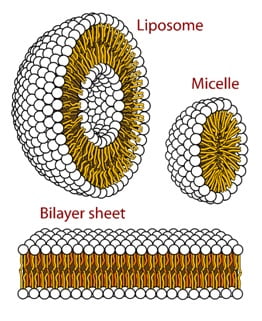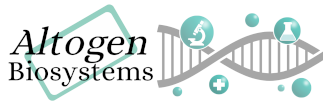Shop Products
Transfection Reagents
Transfection, the technique of transferring foreign particles and nucleic acids into cells, is a powerful technique that can be facilitated through chemical means. Transfection reagents are used to enhance the efficacy of genetic experiments, allowing for substantial research to be conducted in the fields of applied gene therapies and the incredible functionality of the genome. In all transfection experiments, the means by which compounds are delivered into cells must be carefully selected. Although viral-mediated transfection has shown certain efficiency, it can also carry some significant immune responses. As a consequence of viral effects coming from transfection, chemical alternatives have been developed. A few of the most prominent chemical-based transfection reagents are described below.
Liposome-based Transfection Reagents

Liposomes are cationic lipids that encapsulate negatively charged nucleic acid sequences. They are attracted to the cell membrane and are integrated into the host cell via endocytosis. The endosome enzymes break down the liposome, and the DNA fragment is released into the cytosol. These vesicles are artificially created from phospholipids, mainly from mixtures containing both negatively charged and neutral lipids that are capable of automatically interacting with the nucleic acids, forming stable structures that enter the cells. The method is relatively nontoxic and ensures the integration of large DNA fragments into the host cell, with high efficacy.
Polyethylene glycol-cholesterol (PEG-Ch) conjugates that have been modified with targeting ligands and molecular conjugates are used for improving the efficacy of the liposome transfection. The Ch2-PEGn can be obtained by esterification, using succinic anhydride cholesterol and polyethylene glycol dissolved in chloroform, concentrated under a vacuum and purified on silica-gel. The cationic liposomes can be obtained by dissolving a mixture of chloroform, Ch2 -PEGn, and DOTAP in chloroform and the removal of the solvent under a rotary evaporator that enhances the formation of a thin lipid film that can be further dried under a vacuum, plus an addition of a 5% glucose solution and sonication.
Polymer-based Transfection Reagents
Cationic polymers bind to negatively charged nucleic acid sequences and the positively charged complex is attracted to the cell membrane and integrated into the host cell via endocytosis. Such reagents include PLGA (poly-lactic-co-glycolic acid), a food grade polymer that can be safely used for transfection procedures, and PBAE (poly-β-amino ester), a polymer that is capable of protecting DNA molecules that are to be delivered inside a host cell. These polymers obtained from PLGA (poly-lactic-co-glycolic acid) and PBAE (poly-β-amino ester) can be used for the safe and efficient delivery of DNA constructs into cultured cells. The double emulsion solvent removal method can be used for preparing the polymer microparticles, with dichloromethane as a solvent, and aqueous solution containing DNA plasmids or RNA-based constructs. Following homogenization and centrifugation, the lyophilization with mannitol can be performed to generate polymer particles used for DNA vaccine development.
A number of polyethylenimine-based polymers were developed and used for transient and stable transfection in several mammalian cell lines, as well as insect and bacterial cells. Polyethylenimine-based polymers can be used for the cultivation of, for example, neuronal cells. Neuronal cell cultures are difficult to cultivate because mature neurons do not undergo cell division. While the lack of cell division can be overcome by tumorous, immortalized neurological cells, this is not the preferred method of cultivation due to the fact that there are major differences between a cancerous neuron and the average neuronal cell. However, polyethylenimine-based polymer coated surfaces help keep neuronal cells from deteriorating.
Nanoparticle-based Transfection Reagents
Nanoparticles are non-viral vectors consisting of inorganic and organic particles and polymers, which can be used for gene delivery and avoiding the toxicity and compatibility problems if the natural biopolymers such as lipids, proteins, and sugars are used. These vectors ensure gene delivery into specific cells or into specific tissues, for cancer therapy, and also for diabetes, autoimmune diseases, and genetic deficiencies.
Nanoparticles consisting of polyethylenimine and tripolyphosphate can be developed using freeze-dry method. Scientists used nanoparticles for siRNA and plasmid transfection into cancer cell lines and primary cell cultures. Most DNA transfection reagents are incompatible with siRNA, which is sensitive to serum, and therefore, nanoparticles play a crucial role in RNAi transfection.
Cell Line Specific Transfection Reagents
Transfection by calcium phosphate was one of the earliest chemical based methods developed to deliver exogenous nucleic acids to cultured mammalian cells. Advances in the development of nanoparticles, liposomes, lipid and polymer-based carrier molecules capable of binding and encapsulating nucleic acids led to the development of new generation of transfection reagents – optimized and cell line specific transfection reagents that provide high transfection efficacy with minimal cytotoxicity. There are a number of commercially available pre-optimized transfection reagents and associated transfection protocols for both in vitro and in vivo transfection applications – see cell line-specific cell transfection kits and in vivo transfection reagents. These reagents and transfection methods are widely used in in basic life sciences research and associated clinical studies.
Cell lines differ in their responsiveness to transfection protocols; certain cells that replicate infrequently are unlikely to demonstrate high transfection efficiency. Consequently, various transfection experiments with different cell types are bound to have different transfection efficiencies. This fact should not discourage transfection applications in research settings, but should rather motivate investment into specific transfection reagents that have been designed for specific cell lines. Research applications of transfection usually concern the effects of transfected nucleic sequences, and hence it is beneficial for laboratories to use optimized reagents that will not result in a loss of time due to repeated transfection trials aimed at increasing efficiency.
What is Transfection Reagent?
A transfection reagent is a chemical or lipid-based substance used to deliver nucleic acids, such as DNA or RNA, into cells. The transfection reagent binds to the nucleic acids and facilitates their entry into the cells by disrupting the cell membrane or promoting endocytosis.
Transfection reagents can be divided into two main categories:
- Chemical transfection reagents: These are small organic molecules that are cationic or amphipathic in nature, and can interact with the negatively charged nucleic acids to form a complex that can enter cells. Examples of chemical transfection reagents include calcium phosphate, polyethylenimine (PEI), and Lipofectamine.
- Lipid-based transfection reagents: These are liposomes or lipid nanoparticles that can encapsulate nucleic acids and deliver them into cells. Lipid-based transfection reagents are often more efficient and less toxic than chemical transfection reagents, and can be used to deliver nucleic acids into a wider range of cell types. Examples of lipid-based transfection reagents include Lipofectamine, TransIT-X2, and FuGENE HD.
The choice of transfection reagent depends on the type of cells being transfected, the nucleic acid being delivered, and the specific experimental conditions. Optimization of transfection conditions is important to achieve efficient and specific delivery of nucleic acids while minimizing cytotoxicity and off-target effects.
About Altogen Biosystems
Altogen Biosystems is a life sciences company dedicated to the development and manufacture of in vitro cell type specific and tissues-targeted in vivo transfection reagents. Efficient delivery of plasmid DNA, RNA, and proteins is enabled by advanced formulation of reagents and specific design of transfection protocols. Altogen Biosystems offers a complete transfection system for a broad range of cell lines. All reagents are functionally tested to be highly reproducible, serum compatible, induce low toxicity, and can be used for co-transfection experiments, and high throughput applications.




